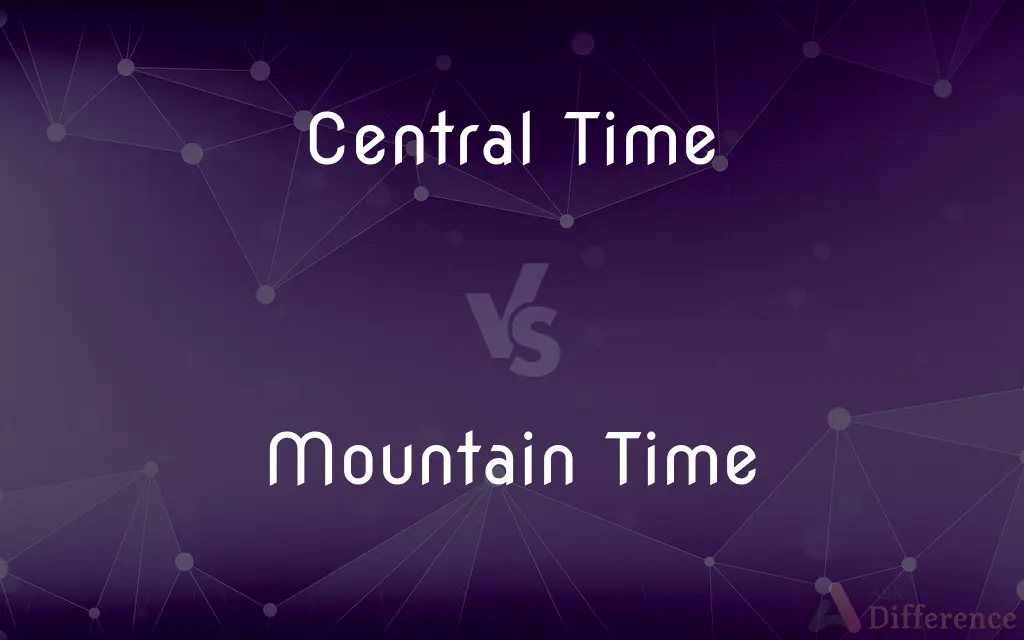Central Time vs. Mountain Time — What's the Difference?
By Urooj Arif & Maham Liaqat — Published on February 25, 2024
Central Time (CT) is typically 1 hour ahead of Mountain Time (MT), affecting local schedules and TV broadcasts. CT spans central USA, while MT covers the mountainous regions.

Difference Between Central Time and Mountain Time
Table of Contents
ADVERTISEMENT
Key Differences
Central Time (CT) is a time zone in the United States and Canada, primarily covering the central region. It is characterized by being 6 hours behind Coordinated Universal Time (UTC-6) during standard time and UTC-5 during daylight saving time. In contrast, Mountain Time (MT) is observed in the mountain regions of the USA and Canada, being UTC-7 during standard time and UTC-6 during daylight saving time.
CT encompasses major cities like Chicago and Dallas, influencing business hours and daily routines significantly. MT, on the other hand, includes cities like Denver and Phoenix (which does not observe daylight saving time), creating a different pace and lifestyle in these areas.
Daylight saving time brings a notable shift; CT moves to UTC-5, while MT adjusts to UTC-6, maintaining the 1-hour difference. However, regions in MT that do not observe daylight saving, like most of Arizona, do not shift, causing occasional overlaps with CT.
Broadcast schedules, especially for live events and television programming, are directly impacted by these time zones. Shows airing at 8 PM CT will be broadcast at 7 PM MT, affecting viewer engagement and prime-time slots.
The choice between CT and MT can influence travel plans, conference calls, and even online gaming sessions, as the 1-hour difference might affect coordination and scheduling across these zones.
ADVERTISEMENT
Comparison Chart
UTC Offset (Standard Time)
UTC-6
UTC-7
UTC Offset (Daylight Saving)
UTC-5
UTC-6
Major Cities
Chicago, Dallas
Denver, Phoenix
Daylight Saving Observation
Yes (except parts of Indiana)
Yes (except Arizona)
Impact on Activities
Influences business hours and TV broadcasts
Affects outdoor activities and lifestyle
Compare with Definitions
Central Time
CT is a time zone observed in the central part of North America.
Chicago switches to Central Daylight Time (CDT) in the summer.
Mountain Time
The time zone impacts outdoor and recreational activities in the region.
Hiking times in the Rockies are often planned according to MT.
Central Time
CT shifts to UTC-5 during daylight saving time.
Dallas advances clocks by one hour to UTC-5 in March for daylight saving.
Mountain Time
MT is the time zone for the mountain regions of North America.
Denver observes Mountain Standard Time (MST) in winter.
Central Time
CT influences TV broadcast times across the U.S.
Prime-time shows air at 8 PM in Chicago's CT zone.
Mountain Time
MT includes areas like Denver, Salt Lake City, and parts of Arizona.
Salt Lake City moves to MDT, UTC-6, in summer.
Central Time
Major U.S. cities in CT include Chicago, Dallas, and Houston.
Business hours in Houston are based on Central Time.
Mountain Time
Standard time in MT is UTC-7.
When it's noon UTC, it's 5 AM in MT during standard time.
Central Time
During standard time, CT is 6 hours behind Coordinated Universal Time (UTC-6).
When it's noon UTC, it's 6 AM in CT during standard time.
Mountain Time
During daylight saving, MT changes to UTC-6.
Phoenix, which doesn't observe DST, remains at UTC-7 year-round.
Common Curiosities
Does Central Time always have a 1-hour difference with Mountain Time?
Yes, except for areas in MT that don't observe daylight saving, like Arizona.
Do all areas in Central and Mountain Time zones observe daylight saving time?
No, areas like most of Arizona (MT) and parts of Indiana (CT) do not observe daylight saving.
How does the time zone difference impact daily routines?
It affects meal times, work schedules, and sleep patterns based on the local time zone.
Do national events follow a specific time zone for broadcasting?
National events are often broadcasted based on Eastern Time, with adjustments for CT, MT, and others.
Are there any U.S. states that observe both CT and MT?
Yes, states like Texas and Kansas have regions observing both CT and MT.
Can the time zone difference affect online activities?
Yes, it can influence scheduling for online games, webinars, and virtual meetings.
Is the entire state of Arizona exempt from daylight saving time?
Most of Arizona does not observe DST, except for the Navajo Nation, which does.
How does daylight saving time affect the CT and MT difference?
The 1-hour difference remains, but local times shift according to daylight saving rules, except for areas not observing it.
How do time zones like CT and MT affect international business?
They necessitate careful scheduling for calls and meetings to accommodate the time differences.
Are TV broadcasts affected nationwide by CT and MT?
Yes, live broadcasts are timed based on the local time zone, affecting airing times across the country.
How do travelers adjust to the time zone difference between CT and MT?
Travelers need to reset their watches and devices to the local time zone upon arrival.
Share Your Discovery

Previous Comparison
Detached Home vs. Semi-Detached Home
Next Comparison
Personal Skill vs. Interpersonal SkillAuthor Spotlight
Written by
Urooj ArifUrooj is a skilled content writer at Ask Difference, known for her exceptional ability to simplify complex topics into engaging and informative content. With a passion for research and a flair for clear, concise writing, she consistently delivers articles that resonate with our diverse audience.
Co-written by
Maham Liaqat















































